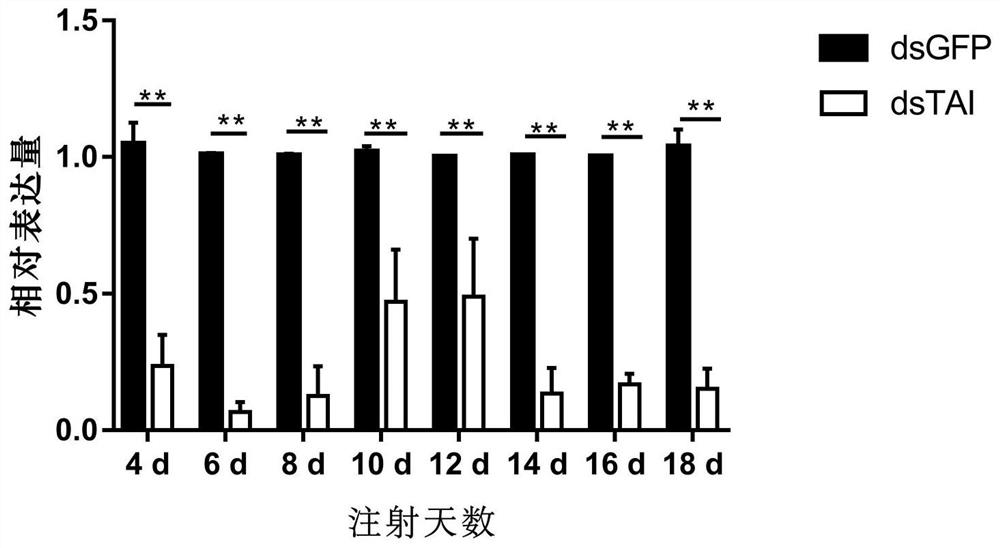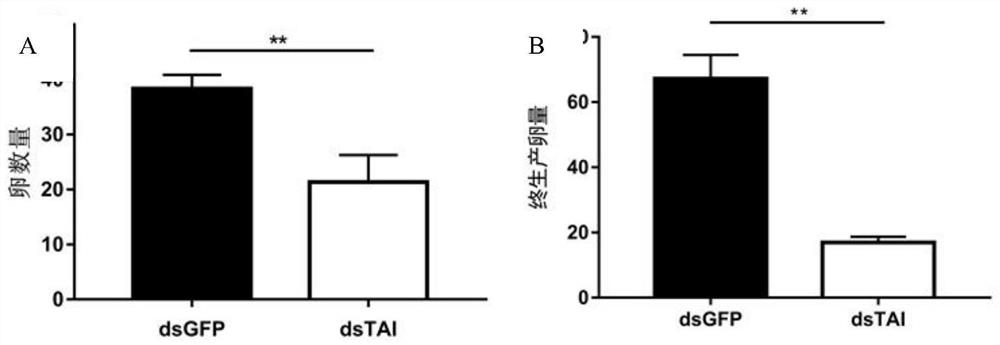An isolated Lygus taiman gene and its encoded protein
A technology of Lygus chinensis and genes, which can be applied in genetic engineering, plant genetic improvement, peptide source, etc., can solve the problems of increased resistance of pests
- Summary
- Abstract
- Description
- Claims
- Application Information
AI Technical Summary
Problems solved by technology
Method used
Image
Examples
Embodiment 1
[0025] Example 1: Cloning and analysis of the Lygus chinensis Taiman gene
[0026] Lygus stinkbug RNA was extracted by TRIzol method, and the extracted total RNA was synthesized into a cDNA template using the RTMasterMix (perfect realtime) kit (specific steps follow the kit instructions). The primer sequences were designed as follows.
[0027] Upstream primer sequence TAI-F: 5'-CGCTTATGCAATGCGAGACG-3',
[0028] Downstream primer sequence TAI-R: 5'-GCCAGTGAGCTGGGCATTGA-3'.
[0029] Using the cDNA of Lygus melanogaster as a template, PCR amplification was carried out using the above primers TAI-F and TAI-R. The recovered PCR product was ligated with the pEASY-T1 vector, the recombinant vector was transformed into competent cells T1, and the ampicillin-resistant LB medium was cultured overnight. After culturing overnight, 8 positive clones were picked for PCR verification, and colony PCR amplified as positive clones were sent for sequencing with fresh bacterial liquid.
[003...
Embodiment 2
[0031] Example 2: Synthetic dsRNA
[0032] According to the Taiman gene sequence that obtains in embodiment 1, design specific amplification primer (5'-end adds T7
[0033] promoter sequence), for the amplification of the dsRNA fragment of Taiman gene, the specific primer of design is as follows:
[0034] Upstream primer sequence dsTAI-F: GCACAGTACAACCTTGGACC,
[0035] Downstream primer sequence dsTAI-R: GTTGAACCTCCACTCCCTCC.
[0036] Using the cDNA of Lygus melanogaster as a template, the above-mentioned primers dsTAI-F and dsTAI-R were used for PCR amplification, and the PCR product was connected to the pEASY-T1 vector. Pick a single colony that is positive in the colony PCR test, send it for sequencing, and check the correctness of the gene sequence. For the single colony with correct sequencing, 6ml LB+AMP medium was shaken overnight.
[0037] Extract the plasmid containing the target fragment, use the plasmid as a template, and use the above-mentioned specific primers ...
Embodiment 3
[0039] Example 3 The silencing efficiency of the gene after injection of Taiman gene dsRNA and its effect on the number and fecundity of eggs in the female ovary
[0040] Using the double-stranded dsRNA of the green fluorescent protein gene (GFP) as a control, the dsRNA of the Taiman gene was injected into the newly eclovened females through the microinjection method from the outermost side of the hind thorax and abdominal intersegmental membrane of Lygus chinensis.
PUM
| Property | Measurement | Unit |
|---|---|---|
| molecular weight | aaaaa | aaaaa |
Abstract
Description
Claims
Application Information
 Login to View More
Login to View More - Generate Ideas
- Intellectual Property
- Life Sciences
- Materials
- Tech Scout
- Unparalleled Data Quality
- Higher Quality Content
- 60% Fewer Hallucinations
Browse by: Latest US Patents, China's latest patents, Technical Efficacy Thesaurus, Application Domain, Technology Topic, Popular Technical Reports.
© 2025 PatSnap. All rights reserved.Legal|Privacy policy|Modern Slavery Act Transparency Statement|Sitemap|About US| Contact US: help@patsnap.com


